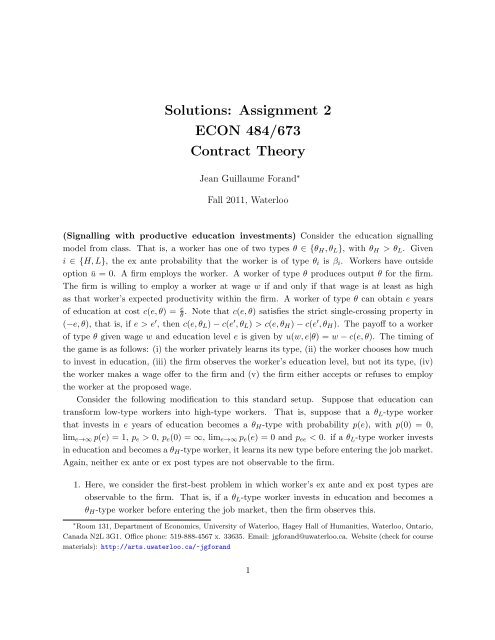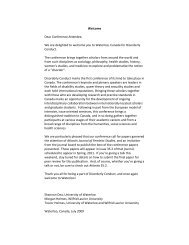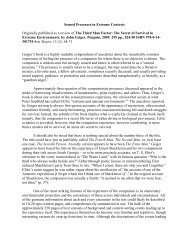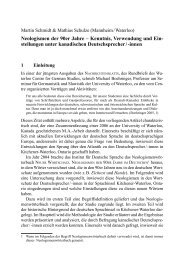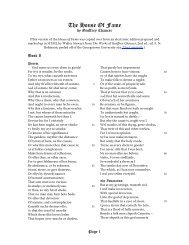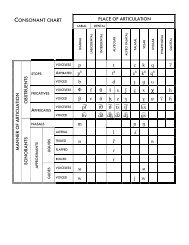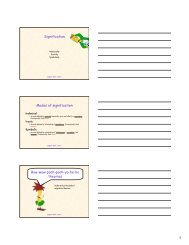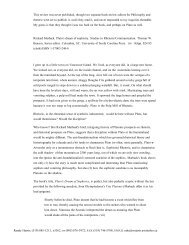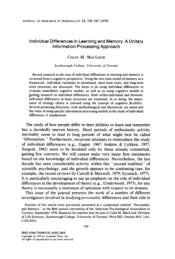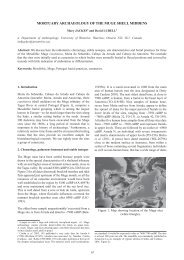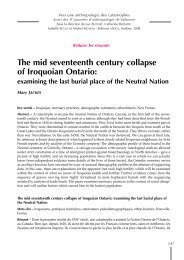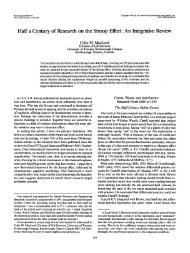Solutions: Assignment 2 ECON 484/673 Contract Theory
Solutions: Assignment 2 ECON 484/673 Contract Theory
Solutions: Assignment 2 ECON 484/673 Contract Theory
Create successful ePaper yourself
Turn your PDF publications into a flip-book with our unique Google optimized e-Paper software.
<strong>Solutions</strong>: <strong>Assignment</strong> 2<br />
<strong>ECON</strong> <strong>484</strong>/<strong>673</strong><br />
<strong>Contract</strong> <strong>Theory</strong><br />
Jean Guillaume Forand ∗<br />
Fall 2011, Waterloo<br />
(Signalling with productive education investments) Consider the education signalling<br />
model from class. That is, a worker has one of two types θ ∈ {θH, θL}, with θH > θL. Given<br />
i ∈ {H, L}, the ex ante probability that the worker is of type θi is βi. Workers have outside<br />
option ū = 0. A firm employs the worker. A worker of type θ produces output θ for the firm.<br />
The firm is willing to employ a worker at wage w if and only if that wage is at least as high<br />
as that worker’s expected productivity within the firm. A worker of type θ can obtain e years<br />
of education at cost c(e, θ) = e<br />
θ . Note that c(e, θ) satisfies the strict single-crossing property in<br />
(−e, θ), that is, if e > e ′ , then c(e, θL) − c(e ′ , θL) > c(e, θH) − c(e ′ , θH). The payoff to a worker<br />
of type θ given wage w and education level e is given by u(w, e|θ) = w − c(e, θ). The timing of<br />
the game is as follows: (i) the worker privately learns its type, (ii) the worker chooses how much<br />
to invest in education, (iii) the firm observes the worker’s education level, but not its type, (iv)<br />
the worker makes a wage offer to the firm and (v) the firm either accepts or refuses to employ<br />
the worker at the proposed wage.<br />
Consider the following modification to this standard setup. Suppose that education can<br />
transform low-type workers into high-type workers. That is, suppose that a θL-type worker<br />
that invests in e years of education becomes a θH-type with probability p(e), with p(0) = 0,<br />
lime→∞ p(e) = 1, pe > 0, pe(0) = ∞, lime→∞ pe(e) = 0 and pee < 0. if a θL-type worker invests<br />
in education and becomes a θH-type worker, it learns its new type before entering the job market.<br />
Again, neither ex ante or ex post types are not observable to the firm.<br />
1. Here, we consider the first-best problem in which worker’s ex ante and ex post types are<br />
observable to the firm. That is, if a θL-type worker invests in education and becomes a<br />
θH-type worker before entering the job market, then the firm observes this.<br />
∗ Room 131, Department of Economics, University of Waterloo, Hagey Hall of Humanities, Waterloo, Ontario,<br />
Canada N2L 3G1. Office phone: 519-888-4567 x. 33635. Email: jgforand@uwaterloo.ca. Website (check for course<br />
materials): http://arts.uwaterloo.ca/~jgforand<br />
1
(a) Write down the problem solved by the first-best wage and education levels, wF B and<br />
eF B.<br />
Solution. For θH-type workers, the first-best problem solves<br />
e<br />
max w −<br />
w,e θH<br />
s.t. w ≤ θH.<br />
For θL-type workers, the first-best problem solves<br />
max<br />
wL,wH,e p(e)wH + (1 − p(e))wL − e<br />
θL<br />
s.t. wL ≤ θL and wH ≤ θH.<br />
(b) Solve the first-best problem. In particular, show that the first-best education level for<br />
θH-types is 0 while that for low types is given by eF B > 0, which solves<br />
pe(eF B) =<br />
1<br />
θL(θH − θL) .<br />
Solution. As in class, the solution to the first-best problem for θH-types has them<br />
not obtain any education and receive wage θH. For θL-types, since the individual<br />
rationality constraints of the firm must bind, the first-best problem solves<br />
max<br />
e p(e)θH + (1 − p(e))θL − e<br />
.<br />
θL<br />
Since pee < 0, pe(0) = ∞ and lime ′ →∞ pe(e ′ ) = 0, this problem has a unique solution,<br />
eF B > 0, such that<br />
pe(eF B) =<br />
1<br />
θL(θH − θL) .<br />
(c) Suppose that education investments become more productive. That is, suppose that<br />
a θL worker that invests in e years of education becomes a θH-type with probability<br />
q(e), where q has the same properties as p except that, for all e > 0, q(e) > p(e). What<br />
happens to first-best education levels? What about the payoffs to θL-types under the<br />
first-best? Interpret these results.<br />
Solution. Under productivity q, the first-best education level for θL-types is e ′ F B<br />
such that<br />
qe(e ′ F B) =<br />
1<br />
θL(θH − θL) .<br />
2<br />
> 0
In general, both e ′ F B ≥ eF B and e ′ F B ≤ eF B are possible. However, note that<br />
q(e ′ F B)θH + (1 − q(e ′ F B))θL − e′ F B<br />
θL<br />
where the first inequality follows since e ′ F B<br />
≥ q(eF B)θH + (1 − q(eF B))θL − eF B<br />
θL<br />
> p(eF B)θH + (1 − p(eF B))θL − eF B<br />
,<br />
is optimal under q and the second since,<br />
for all e, q(e) > p(e). Hence, the first-best payoff to θL-types under q is higher than<br />
under p. When education is more productive, ex ante θL-types are always better off<br />
under the first-best. However, exactly because education is more productive, it could<br />
be that this leads ex ante θL-types to reduce their first-best education levels.<br />
2. We now consider the second-best problem in which neither ex ante or ex post types are<br />
observable to the firm. We focus on perfect Bayesian equilibria in pure strategies.<br />
(a) Consider separating equilibria, that is, equilibria in which eH �= eL.<br />
i. Show that in any separating equilibrium, θL-types set eL = eF B.<br />
Solution. Consider a separating equilibrium in which eL �= eF B and a deviation<br />
by a θL-type worker to eF B. Let βJ(e) denote the equilibrium belief of the firm<br />
that the worker’s ex ante type was θJ following an education level of e. Then the<br />
payoff to this deviation satisfies<br />
[βH(eF B) + p(eF B)βL(eF B)]θH+(1 − p(eF B))βL(eF B)θL − eF B<br />
θL<br />
≥ p(eF B)θH + (1 − p(eF B))θL − eF B<br />
θL<br />
> p(eL)θH + (1 − p(eL))θL − eL<br />
,<br />
contradicting the claim that eL is an equilibrium choice, since the final line corresponds<br />
to the equilibrium payoff of θL-types.<br />
ii. Characterise the set of education levels for θH-types, eH �= eF B, that can be<br />
achieved in a separating equilibrium.<br />
Solution. Let êH > 0 be the unique solution to<br />
pe(êH) =<br />
1<br />
θH(θH − θL) .<br />
Note that êH > eF B. I claim that eH �= eF B is a separating equilibrium education<br />
level for θH-types if and only if<br />
� �<br />
eH ∈ θL θH − [w(eF B) − eF<br />
� �<br />
B<br />
] , θH θH − [w(êH) − êH<br />
��<br />
] , (1)<br />
3<br />
θL<br />
θH<br />
θL<br />
θL
where w(e) = p(e)θH + (1 − p(e))θL. To show this, first note that condition (1)<br />
is necessary for an education level eH to be sustained in a separating equilibrium.<br />
That is, under a separating equilibrium with education eH for θH-types, we must<br />
have that<br />
and that<br />
θH − eH<br />
θH<br />
w(eF B) − eF B<br />
θL<br />
≥ [βH(êH) + p(êH)βL(êH)]θH + (1 − p(êH))βL(êH)θL − êH<br />
≥ w(êH) − êH<br />
,<br />
θH<br />
≥ θH − eH<br />
.<br />
θL<br />
Second, note that condition (1) is sufficient for an education level eH to be sustained<br />
in a separating equilibrium. That is, if eH satisfies condition (1), the<br />
following strategies and beliefs form a separating equilibrium: θL types obtain education<br />
level eF B, θH-types obtain education level eH, βH(eH) = 1 and βL(e) = 1<br />
for all e �= eH. Given any e �= eH, we have that<br />
w(eF B) − eF B<br />
θL<br />
≥ w(e) − e<br />
,<br />
θL<br />
by the definition of eF B. Also, we have that<br />
w(eF B) − eF B<br />
θL<br />
≥ θH − eH<br />
,<br />
θL<br />
since eH satisfies (1). Hence, eF B is optimal for θL-types. Similarly, given any<br />
e �= eH, we have that<br />
θH − eH<br />
θH<br />
≥ w(êH) − êH<br />
≥ w(e) − e<br />
θH<br />
θH<br />
,<br />
where the first inequality follows from (1) and the second from the definition of<br />
êH. Hence, eH is optimal for θH-types.<br />
iii. Does a separating equilibrium always exist?<br />
Solution. This question reduces to whether the set of effort levels in (1) is<br />
nonempty for any values for the model’s parameters. It turns out that a separating<br />
equilibrium always exists, although the argument establishing this is more<br />
complicated than I anticipated. For any θ ∈ [θL, θH], let<br />
e<br />
U(θ) = max w(e) −<br />
e θ .<br />
4<br />
θH
By the envelope theorem, we have that U ′ (θ) = êθ<br />
θ 2 , where êθ is the solution to<br />
the maximisation problem above (note that êθL = eF B and êθL = êL). Hence, we<br />
have that<br />
U(θH) = U(θL) +<br />
� θH<br />
θL<br />
> U(θL) + eF B<br />
= U(θL) + eF B<br />
êθ<br />
dθ<br />
θ2 � θH<br />
θL<br />
1<br />
dθ<br />
θ2 θH − θL<br />
θHθL<br />
,<br />
where the inequality follows from the fact that êθ is increasing in θ. Using these<br />
results, we have that<br />
�<br />
θH θH − [w(êH) − êH<br />
� �<br />
] −θL θH − [w(eF B) − eF<br />
�<br />
B<br />
]<br />
as desired.<br />
θH<br />
θL<br />
= θH [θH − U(θL)] − θL [θH − U(θL)]<br />
�<br />
> (θH − θL) θH − U(θL) − eF<br />
�<br />
B<br />
= (θH − θL) [θH − w(eF B)]<br />
≥ 0,<br />
iv. Suppose, as in question 1(c), that education investments become more productive,<br />
that is, that a θL worker that invests in e years of education becomes a θH-type<br />
with probability q(e) instead of p(e). What is the effect of this on the education<br />
levels for θH-types that can be sustained in separating equilibria? Interpret this<br />
result.<br />
Solution. We can rewrite the set of θH-type education levels from condition (1)<br />
as [θL[θH − U(θL)], θH[θH − U(θH)]]. Since, as shown in question 1(c), U(θ) is<br />
higher under q than under p for any θ, we have that both the minimal and the<br />
maximal level of education attained in a separating equilibrium are lower under<br />
q than under p. When education is more productive, ex ante θH-types have less<br />
incentives to obtain high levels of education just to separate themselves from θLtypes,<br />
since they can use their lower costs to education to obtain higher wages by<br />
convincing the firm that they are likely to be ex-post θH-types through education<br />
investments. Similarly, when education is more productive, ex ante θL-types have<br />
less incentives to mimic θH-type education investments since their wages increase<br />
even when firms know (in equilibrium) their initial types.<br />
(b) Consider pooling equilibria, that is, equilibria in which eH = eL = e ∗ .<br />
5<br />
θL
i. Given a pooling equilibrium with education level e ∗ , what is the wage received by<br />
the worker?<br />
Solution. We have that w P (e ∗ ) = [βH + p(e ∗ )βL]θH + βL(1 − p(e ∗ ))θL.<br />
ii. Characterise the set of education levels e ∗ that can be achieved in a pooling<br />
equilibrium.<br />
Solution. I claim that e∗ is an education level in a pooling equilibrium if and<br />
only if<br />
e ∗ � �<br />
≤ min θH w P (e ∗ �<br />
) − w(êH) − êH<br />
�� �<br />
, θL w<br />
θH<br />
P (e ∗ �<br />
) − w(eF B) − eF<br />
���<br />
B<br />
(2)<br />
θL<br />
To show this, first note that condition (2) is necessary for an education level e ∗ to<br />
be sustained in a separating equilibrium. That is, under a separating equilibrium<br />
with education e ∗ , we must have that<br />
w P (e ∗ ) − e∗<br />
θH<br />
≥ [βH(êH) + p(êH)βL(êH)]θH + (1 − p(êH))βL(êH)θL − êH<br />
≥ w(êH) − êH<br />
,<br />
θH<br />
and that, following a similar argument<br />
w P (e ∗ ) − e∗<br />
θL<br />
≥ w(eF B) − eF B<br />
θL<br />
.<br />
Second, note that condition (2) is sufficient for an education level e ∗ to be sustained<br />
in a pooling equilibrium. This follows by constructing equilibria in a manner very<br />
close to that in question 2(a)ii.<br />
iii. Does a pooling equilibrium at e ∗ = 0 always exist? What about at e ∗ = eF B?<br />
Solution. A pooling equilibrium at e ∗ = 0 does not always exist. To see this,<br />
suppose that p is such that eF B, êH ≈ 0 and p(eF B), p(êH) ≈ 1. Then condition<br />
(2) requires that<br />
e ∗ = 0 ≤ min{θH[βHθH + βLθL − θH], θL[βHθH + βLθL − θH]} < 0,<br />
a contradiction. If e ∗ = eF B, then since w P (eF B) > w(eF B), condition (2) reduces<br />
to<br />
eF B ≤ θH[w P (eF B) − w(êH)] + êH,<br />
which is necessary and sufficient for such a pooling equilibrium to exist.<br />
iv. Suppose, as in question 1(c), that education investments become more productive,<br />
that is, that a θL worker that invests in e years of education becomes a θH-type<br />
with probability q(e) instead of p(e). What is the effect of this on the education<br />
levels e ∗ that can be sustained in pooling equilibria? Interpret this result.<br />
6<br />
θH
Solution. As in question 2(a)iv., we can rewrite the righthand side of condition<br />
(2) as min{θH[w P (e ∗ ) − U(θH)], θL[w P (e ∗ ) − U(θL)]}. Since U(θH), U(θL) and<br />
w P (e ∗ ) are higher under q than under p, the effect of this change on the education<br />
levels sustained in pooling equilibria is ambiguous. When education is more<br />
productive, wages rise in a pooling equilibrium, but so do the value of workers’<br />
‘outside options’, which is to invest in enough education that firms believe them<br />
to be of ex post θH-type with high probability.<br />
v. With productive investments in education, do any pooling equilibria satisfy the<br />
intuitive criterion?<br />
Solution. As in the simple model in class, no pooling equilibria survive the intuitive<br />
criterion when education investments are productive. Note that the most<br />
favourable beliefs about the worker that the firm can hold following any education<br />
level is that the worker was an ex ante θH-type. Hence, we can follow the same<br />
argument as in class for the simple model: given favourable beliefs by the firm,<br />
the education level that keeps the ex ante θL-type worker indifferent between its<br />
pooling equilibrium payoff and a deviation to this education level is strictly preferred<br />
by the ex ante θH-type worker. Hence, the intuitive criterion requires that<br />
equilibrium beliefs be such that (nearby) such deviations are attributed to ex ante<br />
θH-types, which is inconsistent with pooling equilibria incentive constraints.<br />
7


